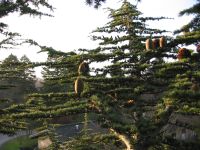Cedar of Lebanon - Cedrus libani
English name:
Cedar of Lebanon
Scientific name:
Cedrus libani
Family:
Pinaceae (Pine family)
Height:
15 m.
Flowering:
September to November
Range:
Lebanon, Syria, Turkey
 |
 |
 |
The Cedrus libani in the centre of the picture are from seed collected in the wild in Turkey in 1962 and was a present from the Gothenburg Botanical Garden in Sweden. It can be found near the entrance, just behind the welcoming sign, in square 916 position 1525.
Plant description:
The genus Cedrus is made up of 4 closely related species. They are the only evergreen conifers with needles sitting in rosettes on short shoots. All are restricted to cool mountain coniferous forests with abundant winter snowfall. This genus has two natural ranges, one around the Mediterranean and the other (for C. deodara) in the Himalayas from Afghanistan to China. Plants of this genus have been used as for timber production, pitch production as well as garden ornamentals. We have 3 species in our collection in Hørsholm and 12 examples of Cedrus libani. Our oldest is from 1953, since no C. libani survived the cold winters in the 1940s. But the present plant material, all directly or indirectly from Turkey, survived the cold winters around 1980 and appear to be hardy in our climate.
Cedrus libani has been in cultivated in Denmark as early as in 1736. However, it is still not common in Danish gardens. Two other species in this genus (C. atlantica & C. deodara) are much more common. Nevertheless if one obtains the right climate-race (provenance) from the high mountains in Turkey, they appear to survive without problems and even produce pollen, cones and filled seed. They can make a magnificent specimen tree given time but will probably not be as large here in Denmark as in England with its much warmer climate. Nevertheless, the cones and foliage are very attractive. Interestingly pollen is released rather late, in the autumn. This year pollen was being shed in the first week of October.
The Cedar of Lebanon is an evergreen coniferous trees. The bark becomes cracked into small scaly ridges with age and turns blackish. Needles are spirally arranged on long shoots. They are 1.5 to 3 cm long and in rosettes of 10-15 on short shoots. Several rosettes can survive on the short shoots at one time. Needles are 4 sided and grey green, with stomata on all four surfaces. The attractive female cones stand upright, and fall apart leaving an upright central axis as in the genus Abies. Cones are barrel-shaped 7- 12 cm long with a flat or indented tip and take at least 2 years to mature. The male cones are also upright, born in abundance on branches exposed to the sun and are also an attractive especially just before pollen shedding. The trees can be almost as wide as they are high if given an open space to grow.
References:
Bean, W.J. 1976 Trees and Shrubs Hardy in the British Isles Vol I. Pp 560-561 A-C. Bean and Murray publishers.
Lange, J. 1994. Kulturplanternes Indførelshistorie i Danmark. (Introduction History of Cultivated Plants in Denmark). Jordbrugsforlaget, Frederiksberg C.
Mabberley, D.J. 1997. The Plant Book. Pp 326. Cambridge University Press, Cambridge, UK.
Mitchell, A. & Ødum S. . 1983. Træer i Nordeuropa. Gads forlag, Copenhagen, 413 pp.
